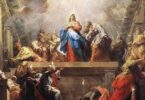The Mass of Easter Day (Year C)
Scriptures: Acts 10:34a, 37-43; Ps. 118:1-2, 16-17, 22-23; Col. 3:1-4; Jn 20:1-9
St. Paul, one of the pillars of the Church, says in his letter to the Corinthians: “If Christ has not been raised, your faith is futile…” (1 Cor 15:17).
How true this is—if Christ had not risen from the dead, we would not have faith, the Church, the sacraments, hope, or a future. The resurrection of Jesus is, therefore, the central and pivotal event upon which our faith is based.
Today, we celebrate the resurrection of Jesus Christ—the central and defining event of all human history. As we celebrate it, we must understand the transformative power of the Resurrection. Every person who truly believed in the Risen Christ experienced a profound change in their life. They did not remain the same; they were transformed. They became witnesses to His Resurrection. They became the messengers of hope. Thus, the Resurrection of the Lord became the sure foundation of the Christian life.
The resurrection of Jesus had a profound effect on the first Christians. It changed the apostles’ understanding of who Jesus truly was. They recognised Him as the Son of God. St. Paul writes that the resurrection confirmed Jesus to be the Son of God (Rom 1:4). Without the Resurrection, Jesus would have been seen as just another prophet. But the Resurrection removed the sting of the cross. What was once viewed as a punishment and a curse became, through the Resurrection, a sign of victory over sin and death. The death of Jesus gave meaning to our suffering and death. Death is no longer the final word. The Resurrection of Jesus is now the final word. It is the foundation of our Christian faith and the source of new life.
This is the power of the Resurrection that changed the lives of the apostles. But perhaps the most important gift the Resurrection brings is hope, revealed through God’s mercy. Humanity, once enslaved by sin, began to believe again in the mercy of God. The people lived in despair, but began to live in hope.
All of today’s readings highlight this truth. In the first reading, St. Peter—himself a recipient of God’s mercy—proclaims a summary of Jesus’ life, death, and resurrection. He confirms that all the prophets of the Old Testament pointed to the fulfilment of God’s promises in the person of Jesus Christ. He ends his preaching with words of hope and consolation: forgiveness is now available through the name of Jesus. The forgiveness of sins gave rise to a new hope—a hope that salvation is possible. This is one of the earliest proclamations about Jesus’ resurrection, and it created hope among the listeners. They began to get baptised in the name of Jesus.
The second reading, from the Letter to the Colossians, was written by St. Paul—another who received deep mercy from the Risen Lord. He believed that all who believe in Christ also share in His resurrection (1 Cor 15:20–23). The passage we read from the letter to Colossians likewise emphasizes transformation. Referring to baptism in Christ, St. Paul insists on a true change in the life of the believer. This is one of Paul’s most powerful and convincing teachings: the resurrection of Christ is the anchor of Christian hope (cf. Rom 8:18ff). This is beautifully captured in the logo of the Jubilee 2025. For Paul, the Resurrection of Jesus is the sure foundation of our future resurrection, when Christ comes in glory.
In the Gospel, we read the first account of the Resurrection. It was still dark when Mary Magdalene went to the tomb. This darkness symbolizes grief, confusion, and despair. The Resurrection of Jesus was not immediately understood; it was a gradual awakening in the hearts of the apostles.
There are three people mentioned in this passage, and each had their own struggle in understanding Jesus’ true identity. Mary went to the tomb out of love, but she was confused—she thought the body had been taken. Peter had denied Jesus and had not yet accepted the reality of the Resurrection. The beloved disciple had remained at the foot of the cross, but still lacked full understanding, for they had not yet grasped the meaning of the Scriptures. All three came to the tomb filled with fear and shock. But the empty tomb became the sign of hope and resurrection.
As we participate in this Easter Eucharist, we are reminded that all those who believed in the Resurrection were filled with hope: St. Peter, St. Paul, the beloved disciple, and Mary Magdalene. Their faith in the Risen Lord became the solid foundation of their hope. Each of them became a proclaimer of Christ’s Resurrection—a messenger of hope to the world.
We, too, are called to be messengers of hope. Let us believe firmly in the Resurrection of the Lord, and like the first witnesses, may the resurrection of Jesus Christ be the sure foundation of our Christian life. Amen.






